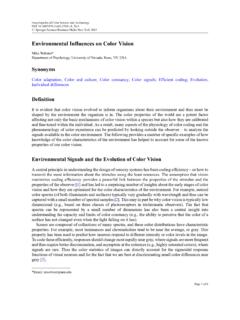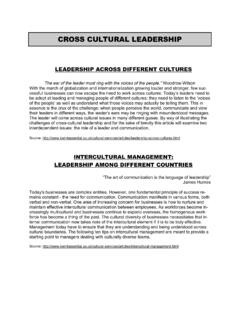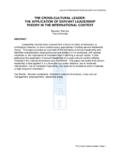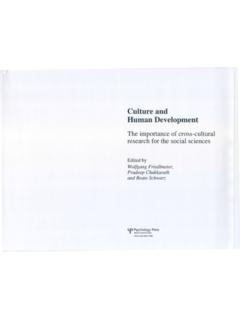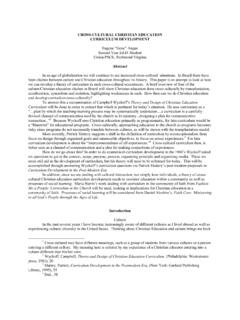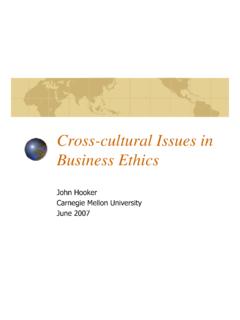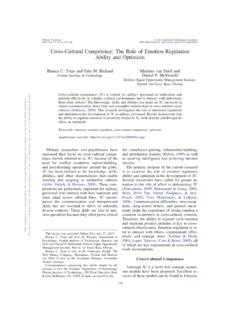Transcription of Comparative (Cross-cultural) Color Preference and …
1 Comparative ( cross - cultural ) Color Preference and Its StructureMiho Saito*Faculty of Human Sciences, Waseda University, 2-579-15, Mikajima, Tokorozawa, Saitama, JapanSynonyms Blue-Seven Phenomenon ; Color Preference ; cross - cultural Color Preference ;Culture and Color ; Preference for white in Asia;Structure of Color preferenceDefinitionSurveys on Color Preference can be found among the veryfirst psychological experiments, with severalfactors thought to be responsible for Color Preference , such as age, gender, and geographical area ofresidence. Although numerous studies have investigated age and gender differences in Color Preference ,very few have concentrated on geographical regions, especially from a cross - cultural from early surveys indicated the existence of cultural differences, especially in Asia where whitewas commonly and strongly preferred by Japanese, Koreans, Chinese, and Indonesians. Subsequentstudies have shown that blue has been consistently preferred in many countries for many years.
2 The term Blue-Seven Phenomenon is used to indicate that blue is the universally favorite Color . The phenomenonrefers to Simon sfinding that subjects selected blue when asked to name a Color and selected seven when requested to choose a number from zero to nine and has been widely researched in many , the associative images which were assumed to be responsible for Color Preference and thesubjects reasons for selecting colors that tended to be liked or disliked regardless of time or place wereclosely connected with the feelings of pleasantness and unpleasantness. Cognitive studies suggest thatthe amygdala is closely connected with Preference in relation to the feelings of pleasantness andunpleasantness, suggesting that the feelings of pleasantness and unpleasantness also play animportant role in determining Color Preference . Based on an analysis of the results of such surveys, ageneral structure of Color Preference was suggested in a three-layered diagram, with preferred feelings of pleasantness and unpleasantness forming the nucleus or the innermostfirst layer, preferences basedon individual factors composing the surrounding second layer, and Preference based on environmentalfactors forming the outermost third Background of Studies on Color PreferenceThe study of Color Preference is of current interest, especially among cognitive psychologists andneuroscientific researchers because Preference is a basic human trait which regulates everyday are numerous studies which have attempted to clarify the mechanism of Preference and to isolatethe factors which influence one s Preference or taste.
3 While there are various research areas concerningthis topic, this entry focuses on the mechanism underlying the Preference for on Color Preference can be found among the veryfirst psychological experiments. Somestudies have been carried out on the Preference for colors associated with particular objects. Many,however, have investigated the affective appeal of Color , not in combination, but separately, so as toevaluate single colors themselves without the influence of other variables.*Email: of Color Science and TechnologyDOI #Springer Science+Business Media New York 2015 Page 1 of 7 Several factors are thought to be responsible for Color Preference , such as age, gender, and geographicalarea of residence. Although numerous studies have investigated age and gender differences in colorpreference, very few have concentrated on geographical regions, especially from a [1] suggested that there was a general order of Preference for fully saturated hues in the orderof blue, red, green, purple, and orange, with yellow ranking last.
4 As this order did not differ betweenCaucasian and other races, he concluded that there was no cross - cultural difference in the Preference forcolors. Choungourian [2] reported the preferences of American, Lebanese, Iranian, and Kuwaiti univer-sity students in Beirut. While red and blue ranked highest in Preference value for the American subjects,those colors ranked lowest for Kuwaitis. Blue-green was ranked as being the least preferred among theAmericans, but was most preferred by both the Iranian and Kuwaiti subjects. He concluded that culturalvariables were an underlying factor in determining Color preferences. On the other hand, a factor analysisstudy by Adams and Osgood [3] found similarities in feelings about colors among 23 cultural [4] demonstrated cross - cultural differences and similarities in Color Preference among ninecultural groups. The groups were Americans, Germans, Danes, Australians, Papua New Guineans,South Africans, Japanese-Americans living in the USA, non-Japanese living in Japan, and hundred subjects were asked to choose the colors they liked and disliked from among 65 coloredchips.
5 Results showed that vivid blue was the only Color that was commonly preferred highly by allgroups, suggesting that cultural variables are indeed involved in Color significantfinding emerging from Saito s study was the distinct Japanese Preference for white. Oneout of every four of the Japanese subjects selected white as theirfirst, second, or third choice, while nosuch high Preference for white was observed in other factor analysis and cluster analysis studies [5,6], a detailed investigation of Color Preference wascarried out on 1600 Japanese in four large cities, considering subjects age, gender, area of residence, andlifestyle. This study also suggested that white was the highest preferred Color , regardless of age, gender, orarea of residence, further indicating the high Preference for white by investigate whether this tendency was unique to Japan, if it may be observed in other Asian areas andif the Preference is influenced by environmental factors such as cultural and geographical aspects, Saito[7] replicated the study in Seoul (Korea).
6 The fact that white was preferred highly not only in Tokyo butalso, even more so, in Seoul led Saito and Lai [8] to conduct the same survey in Taipei (Taiwan), which isclose to Japan both geographically and culturally, to further test the hypothesis that the strong preferencefor white is based to some degree on geographical and cultural variables. The result of the survey indicatedthat the high Preference for white was common in Taipei as Preference for white in China has long been noted in studies, beginning with those by Chou andChen [9] and Shen [10]. Chou and Chen postulated two possible explanations for this Preference :association influence and tradition influence. As the most frequently used Color word in Chinese literaturewas the character for white, they postulated that the subjects Preference was based on familiarity, ,frequency of association. The second possibility, tradition influence, was that their Preference derivedfrom the Color of their nationalflag. (It is to be noted that the colors of theflag were not the same then asthe present-dayflags).
7 Shen, however, questioned Chou and Chen s explanations and offered an alterna-tive explanation which combined Chou and Chen s concept of association frequency with languageinfluence. For example, he noted that the Chinese character for white is associated not only with purenessbut also with everything open, clear, and unselfish, while grayness (gray was the least preferred Color intheir study) is a symbol for everything negative, disappointing, discouraging, or [11] extended the area of investigation to Tianjin in China and Jakarta in Indonesia in order toinvestigate the Preference for Color in more detail with special emphasis on the Preference for white toestablish whether or not a strong Preference for white is common to Asian areas which have bothEncyclopedia of Color Science and TechnologyDOI #Springer Science+Business Media New York 2015 Page 2 of 7geographical and cultural proximity. As a result, it was found that while white was strongly preferred inboth areas, the reasons for the Preference were different.
8 In Japan, white was mostly preferred because ofits associative image of being clean, pure, harmonious, refreshing, beautiful, clear, gentle, and natural. InChina, the reasons for the choice were mainly in association with chastity or purity. Chinese also preferredwhite because it was elegant, clean, beautiful, and pure white. It was also found that white is also asymbol of sacredness for them. Several subjects were reported as stating that white was the source ofevery Color suggesting it to be substantial and unique. In Indonesia, white was reported as being mostlypreferred for its image of being clean, chaste, neutral, and associative images stated above were assumed to be responsible for the strong Preference for , it should be noted that in China, white was found to be sometimes disliked, especially by malesubjects because of its lifelessness, emptiness, loneliness, and image of death. And some Indonesiansubjects were reported to have also disliked white, although only very slightly, because it was too light,too easy to become dirty, and too simple.
9 However, for Indonesian subjects, it was found that white did nothave the image of death as it did for the possible explanation of the Preference for white in Japan is that literature on ancient Japanesereligion and mythology states that ancient people believed in the power of the Sun. This belief can still befound in Japanese Shintoism. The Sun Goddess is called Amaterasu- mikami. As white represented thecolor of the Sun or sunshine, people accepted it as a sacred Color . This is shown by Shinto priests wearingholy white costumes and also holding a sacred wand called agohei, a purifying implement with whitestrips of paper used while they pray ( ). Such items which imply that white is a sacred Color can stillbe seen throughout the country. There are examples, especially in folklore, of even white objects oranimals becoming objects of worship at times. In this way, white had special meaning for people whorevered the sun. For those people, this may explain why the Color quite naturally came to be favored 1 Photograph of a Gohei (white strips of paper) for a purification (With permission from Office of Public Relations,Waseda University)Encyclopedia of Color Science and TechnologyDOI #Springer Science+Business Media New York 2015 Page 3 of 7 Studies on the Blue-Seven Phenomenon The Blue-Seven Phenomenon has been widely researched in many countries since it wasfirst reportedby Simon in 1971.
10 It refers to Simon sfinding that over 40 % of American subjects selected blue whenasked to name a Color and over 30 % selected seven when requested to choose a number from zero tonine. This phenomenon has been confirmed by studies in the USA, Australia, and Kenya. In order toinvestigate Color and number preferences in Japan, Saito [12] asked 586 university undergraduates(239 men and 347 women, average age= ) (1) to name the Color whichfirst comes to mind,(2) to name his or her favorite Color , and (3) to select his or her preferred number from zero to students were reported to have selected blue ( %) most frequently followed by red( %) when they were asked to name a Color (question 1). Blue, red, white ( %), and black( %) together accounted for approximately 80 % of the responses. Further, a gender difference wasreportedly found in the selection of colors, with blue and black being preferred more by men and red andwhite being preferred more by women. On the other hand, in response to question 2, the top four colorswere the same, but red was not chosen as frequently as blue as the preferred Color (red, %; blue, %).

